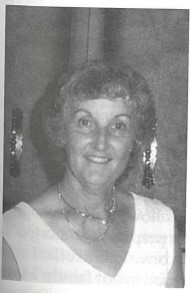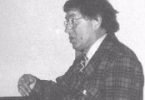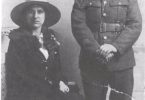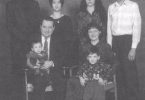Born in 1922, I was the fifth daughter in a family of nine children, born and raised in the Ramsay and Inglewood districts of Calgary. My father was a freight train conductor and almost all of the neighbourhood families were employed by the C.P.R. During the Depression years, my father was away from home months at a time, following the available jobs, while my mother was home, looking after the large house and family. No one had much of anything in those days, so it was a closeknit, sharing community. I remember lots of good times in school and neighbourhood, including Friday evenings in the gym adjacent to Trinity Church where the kids played music and danced.
At Christmas, my father would announce the date and time the Christmas tree would arrive. He would select a fine specimen on his route near Field, B.C., load the tree on the caboose and continue on to Calgary. We youngsters would excitedly meet the train and help to carry our tree home.
I started school at age five, attending the cottage and bungalow schools across from Colonel Walker School, skipped grade three and then completed some of my schooling at Colonel Walker. I took grade nine in junior high at Colonel Walker but went to Western High for my high school years. Because I was a year younger than my classmates, I was always trying to keep up to the older kids. I recall a skating party at an outdoor rink. There was a 9:00 p.m. curfew for my age group, but I defied it, and my mother who tried to nab me. When I finally got home at 10:00 p.m. with my older friends, Mother was not amused. I was “grounded” for a significant period of time. She was also an enforcer of household chores. I still remember my chagrin when forced to delay my planned date with a young Australian serviceman, in order to complete those required tasks.
Because Dad worked on the railroad, we lived near the railroad yards. During the Depression years, hundreds of young men travelled across Canada on the boxcars, looking for work. Mother fed many of them; she would make up sandwiches for them but if they knocked on the door around the time we were to eat, she would invite them in to eat with us. She always insisted they wash before they sat at the table. I think some were as grateful for the wash as for the meal. Many offered to do chores in return.
In 1939, after leaving school, I joined a girlfriend in Nelson, B.C., finding a job in the meat department of the local Safeway store. Instead of just weighing and packing items, I received on-the-spot training as a butcher. During the war, my girlfriend’s boyfriend signed up in the R.C.N. (Royal Canadian Navy) just before the war started. His ship was torpedoed in the Atlantic and there were no survivors. They were the first Canadians lost in the Second World War. Also, there were six other young boys (personal friends of mine who I skated with and went to dances with) killed during the war. This was from one neighbourhood in Calgary which was a small city at that time. I think this gives an indication of the great loss of life of young men during the Second World War.
During the two years in Nelson, I had maintained a friendship and correspondence with a Calgary school friend, Raymond Bibby, who was then stationed on the West coast with R.C.N.V.R. (Navy). He was due for a one-week leave in Calgary, and proposed I join him and we’d get married. That’s exactly what I did! We were married in 1942, just after my twentieth birthday. Ray was then posted to Halifax and I soon boarded a train, travelled East, and settled into a boarding house room. I was there for a few months before seeing my husband, but I kept busy with a job in Simpson’s china department. At that point, I’d had enough of the boarding house. We were allowed a hot bath only once a week, there was little privacy, and I was expected to do chores in addition to paying for room and board. A two-room suite became available, near the Simpson’s store and I painted and papered the walls, and furnished it for $80.00!
In 1944, Ray and I moved to Ste. Hyacinthe (Quebec). In August, 1945, I went home to Calgary to have my baby, Gord, as Ray was expecting to go to the Japanese front. Ray was demobilized in 1945 and returned to Calgary when Gord was four months old. At that time, I was diagnosed with a severe case of T.B. and spent the next three years in the Baker Sanitarium in Bowness. My mother-in-law looked after Gord and I saw my little son just once in all that time. Even after my release from hospital, I had to take life as easy as possible for several years, to prevent recurrence of the disease. When Gord was ten years old, we adopted three-week-old Susan, and four years later, newborn Stephen. During this period, we built a house in Cambrian Heights in Northwest Calgary. Some time later, my marriage came to an end, and I was faced with the responsibility of supporting my children. I attended Mount Royal College for a time, studying interior design, but instead chose a career in Real Estate, which I loved. However, the pressure of making house sales at all hours, while raising teenagers, proved too stressful. I was pleased to accept a property management job with a local builder and a regular work schedule out of my house. After the company sold its interests in about 1980, I took a job using a power machine, making mattresses, cushions, etc.
In 1987, I retired and faced the decision of where to live. I first considered Nelson, B.C., but my thoughts turned to Canmore when visiting my niece and sister-in-law. One beautiful fall day, I went for a walk and took a look at the Seniors’ apartments at Bow River Lodge. I decided to add my name to their waiting list. It wasn’t long before I was notified of a vacancy, and, in the midst of the Olympic Winter Games in February, 1988, I moved into my Canmore home. I love the town, the mountains, and the golf course. I play golf and bridge and am on the executive of the Canmore Seniors Association. I have made many good friends over the years.
My three children, five grandchildren and three great-grandchildren live in Alberta and British Columbia. Each year, on the Heritage Day weekend, we have a grand family camping reunion, celebrating our close family ties.
Growing up with two kids in every bed, no car, not even a radio in our home, we were happy. We made our own fun, explored our environment and shared our life experiences with our neighbours. It seems to me that today, technology has overtaken us, children are over-organized and families are transient or too busy to get involved with their neighbours. Much, I firmly believe, can be learned from those early years.

Grace Bibby
In Canmore Seniors at the Summit, ed. Canmore Seniors Association, 2000, p. 12-13.







